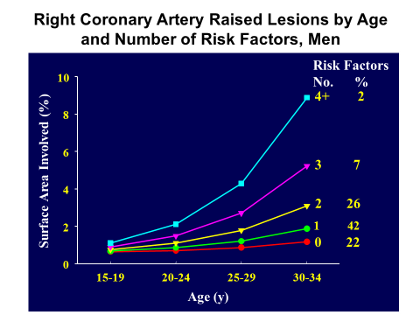Gidding - Figure 9 - RCA lesions, age, risk Text
This Figure shows the increasing risk with age with increasing number of risk factors, and this serves to underline the importance of identifying additional risk factors in individuals with FH. The data are from the Pathobiological Determinants of Atherosclerosis in Youth (PDAY) study,[18] which correlated atherosclerotic burden measured directly at autopsy and risk factors measured postmortem. The data, in 5-year increments, represent the amount of advanced American Heart Association grade 4 or 5 atherosclerotic lesions, by age and by number of risk factors, and it is clear that as the number of risk factors increases, the severity of advanced atherosclerosis increases. What is most important about these data is to recognize that advanced atherosclerosis develops beginning late in the second decade of life and accelerates dramatically in the third and early fourth decades. This again underlines the importance of recognizing these risk factors very early in life and treating them early, because this represents the best opportunity to arrest the entire atherosclerotic process and preclude or at least retard the development of advanced atherosclerosis and plaque.
J Clin Lipidol. 2011; 5(6).References
[18]Cornhill JF, Herderick EE, Vince DG. The clinical morphology of human atherosclerotic lesions. Lessons form the PDAY studay. Pathobiological Determinants of Atherosclerosis in Youth. Wien Klin Wochenschr 1995;107(18): 540-543.
